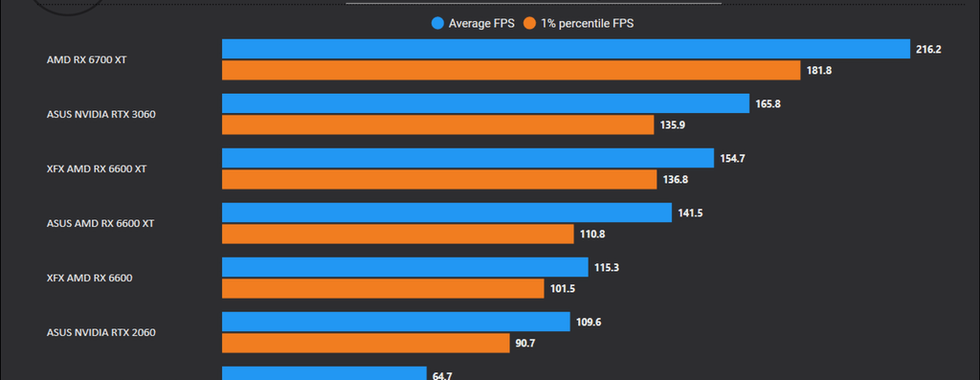Crypto Miners - DON'T Watch This! RX 6600 Review
- A2K
- Oct 13, 2021
- 6 min read
Updated: Sep 3, 2023
I know many of you are already sick of this, but we have yet another GPU release and this one is from AMD - it is RX 6600, the cut down version of the RX 6600 XT that came out just a short while ago. AMD claims that this card is 10-20% slower than its big brother and still able to deliver around 100 FPS in triple A titles at 1080p. While losing 20% of performance may shy some people away - I believe this card will completely sell out for another reason. Keep reading, I will explain why.
First let's compare these two cards - starting with similarities. Both of these cards have the same chip codenamed NAVI 23, they both have same die size, same 8 lane PCIE Gen 4 interface, same 32 MB infinity cache and 8GB of GDDR6 memory on 128 bit interface, but that's where similarities end.
XT variant has its memory running at 16 Gigabits per second while non XT is running at 14, which results in memory bandwidth drop by approximately 14%. The other major difference is the amount of compute units and ray accelerators. We go from 32 to 28 and lose about 256 stream processors. On top of all of this, the GPU game and boost clocks have gone down, which in the end also reflects on the total board power going down from 160W to 132W. That is a 21% reduction in power consumption.
This is one of the things I’d like to focus on more as I think it may be the main selling point of the card. First let’s check out some gaming benchmarks for which we are using a mix of cards from both AMD and Nvidia with the latest addition of RX6600. This particular card is made by XFX and it is the SWFT 210. It is clear that RX 6600 is just a cut down version - so much so, XFX has even used the box from the XT model and put a sticker over it. If you look closely it still shows XT on it. It is funny, but makes no real world difference.
This card has a dual slot dual fan design and it features single HDMI 2.1 and three Display ports. This is a more budget card set-up, so we will have to see how it does on thermals and acoustics a bit later on in the video.
The tests were carried out on our Ryzen 9 5950X bench without overclocking the CPU or the GPU, simply enabling DOCP profile for the RAM, while keeping the rest of the component settings as they were out of the box.
In Shadow of the Tomb Raider at 1080p we immediately see that the new card is about 15% slower than the XT variant and about 18% behind 3060. It beats out 2060 by a small margin.
In 1440p it is a bit of the same, but it still has playable framerate.
In Horizon Zero Dawn at 1080p it is clear that we are bottlenecked elsewhere on the system. Everything considered - this is still a very good frame rate for this game. At 1440p it drops about 11% behind the XT version and is just 5% faster than 2060.
Another very demanding game is Total War Three Kingdoms. Here at 1080p 6600 is actually losing to 2060 by 10% on average FPS but is 21% faster on the 1 percentiles. Very similar story is happening at 1440p too, but this is no longer playable frame rate on any of these cards apart from 6700 XT.
Next up, a game that will likely even run on a well optimised potato - Doom Eternal. Here at 1080p we see again 6600 is performing below 2060 on both average fps and 1 percentiles. Turning the resolution up to 1440p helps 6600 and now it leads over 2060 but that is last generation card from Nvidia so performance here is not the greatest.
Moving on to a few games with Ray Tracing and the first game is Godfall. This game is certainly well optimised for AMD and it shows as performance seems to be on par with the ASUS variant of the 6600XT and just 10% behind XFX’s own XT version. I can say one thing though - while benchmarking this, there was clear stuttering at times and it really shows on the one percentiles.
The second Ray Traced game is Riftbreaker at 1080p. This one has a pretty small spread between most of the cards, same can be said for the 1440p. If you intend to play this game, then either one of these cards will do the trick.
Based on all of these results, it seems if you are on a tight budget and you want to get something for 1080p gaming - then pick up NVIDIA 2060 and call it a day, right? If you purely look at performance, it is clear RX 6600 and RTX 2060 keep trading blows, and depending on the price, it might actually make sense to go for a second hand 2060. But there is more to this.
I already mentioned that this card, just like the 6600 XT, runs on 8 PCIe Gen 4 lanes. What this allows you to do, is purchase a motherboard that has multiple PCIE expansion slots and install graphics card as well as multiple NVME drives and some sort of expansion card like capture card to talk directly to the CPU without sharing the bandwidth with other devices via on-board chipset.
This card is also very power efficient. Let me show you a few examples of this, starting with Horizon Zero Dawn at 1080p. In this game if you remember, there was a bottleneck on the system and all the cards were delivering the same frame rate. When we delve deeper, we can check FPS per 10 Watt and here 6600 is leading with 10.7 FPS which is 22% better than its XT counterpart and 38% better than 3060. If we up the resolution to 1440p, the difference drops but it is still 10% better than XT and 27% better than 3060 which is still very impressive.
Another example is Shadow of the Tomb Raider - here at 1080p we find 6600 is about 16% better than XT version and 29% better than 3060. If we look at the sad 2060 that it is competing with, in terms of FPS then the difference is 43%. When we raise resolution to 1440p, the ratios stay very similar.
This power efficiency lead does not translate in all games. For example, in Doom Eternal at 1080p while 6600 is still at the top, it is matched with all other AMD cards and leads over 3060 only by 16%. What is interesting, in this example RTX 2060 had a higher framerate, but it is 36% less efficient.
So what does all of this mean? First off, it is really important to have a clear idea on what performance level in games you want to achieve. If you intend to play at 1080p, then most of the recent cards will do well enough, and if you start looking at things like DLSS and FSR, you can stretch that performance quite far. There are clear benefits to having a much more efficient card, starting with the most obvious - you need to use less power which is cheaper and you can get away with lower capacity power supply.
If you play games on your PC an hour a day, then the amount of power you save may be only a few dollars per year, but on the flip side this is where we have an issue for card availability - super energy efficient cards will be in high demand for crypto miners. If they are able to save even 20% on their electricity bill, when looking at a 24 hour operation with potentially hundreds of cards - this can be the difference between making profit or losing money.
The other benefit of having a power efficient card is the need of less cooling, which should translate to cheaper GPU and quieter operation. To test this theory we ran Time Spy on loop to stress test the card and see how it performs. We ran it for 10 loops and found it delivered an average of 53 FPS and topped out at 67 degrees Celsius. During the test we also checked the acoustics and at 50cm distance it hit 34.3 dBa, which is really quiet.
As a comparison, ASUS 6600 XT on average hit 61 FPS and topped out at 61 degrees Celsius. The notable difference here is acoustics. ASUS card was louder at 40 dBa, but to be fair both cards are certainly within reasonable range.
To sum all of this up - should you buy this GPU? It all comes down to price and availability. Since these cards are using smaller Navi 23 chips, with some luck we will see more of them available on the market. But from everything I’ve seen so far, the idea of budget cards costing 300 to 400 dollars is gone, and manufacturers know that, so expect pricing to be somewhere in between recommended retail price and scalper price. That's if miners don’t take them all in one big swoop. I would recommend also keeping an eye on a second hand market for a last gen card as you may have some opportunities there.
_______________________________________________________
Affiliate disclosure: as an Amazon Associate, we may earn commissions from qualifying purchases from Amazon.


































































